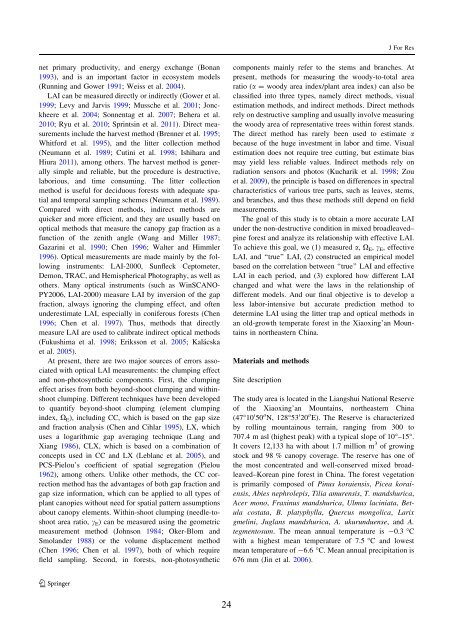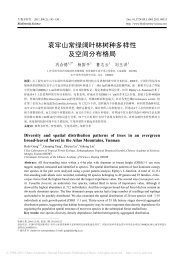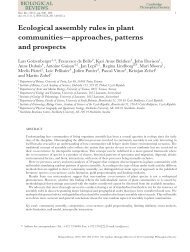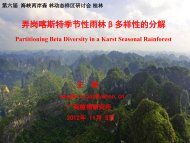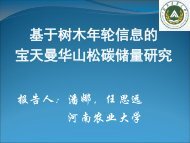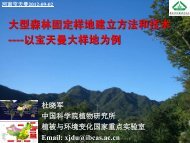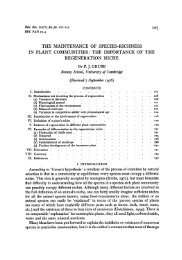Contents - ä¸å½æ£®æçç©å¤æ ·æ§çæµç½ç»
Contents - ä¸å½æ£®æçç©å¤æ ·æ§çæµç½ç»
Contents - ä¸å½æ£®æçç©å¤æ ·æ§çæµç½ç»
- No tags were found...
Create successful ePaper yourself
Turn your PDF publications into a flip-book with our unique Google optimized e-Paper software.
J For Resnet primary productivity, and energy exchange (Bonan1993), and is an important factor in ecosystem models(Running and Gower 1991; Weiss et al. 2004).LAI can be measured directly or indirectly (Gower et al.1999; Levy and Jarvis 1999; Mussche et al. 2001; Jonckheereet al. 2004; Sonnentag et al. 2007; Behera et al.2010; Ryu et al. 2010; Sprintsin et al. 2011). Direct measurementsinclude the harvest method (Brenner et al. 1995;Whitford et al. 1995), and the litter collection method(Neumann et al. 1989; Cutini et al. 1998; Ishihara andHiura 2011), among others. The harvest method is generallysimple and reliable, but the procedure is destructive,laborious, and time consuming. The litter collectionmethod is useful for deciduous forests with adequate spatialand temporal sampling schemes (Neumann et al. 1989).Compared with direct methods, indirect methods arequicker and more efficient, and they are usually based onoptical methods that measure the canopy gap fraction as afunction of the zenith angle (Wang and Miller 1987;Gazarini et al. 1990; Chen 1996; Walter and Himmler1996). Optical measurements are made mainly by the followinginstruments: LAI-2000, Sunfleck Ceptometer,Demon, TRAC, and Hemispherical Photography, as well asothers. Many optical instruments (such as WinSCANO-PY2006, LAI-2000) measure LAI by inversion of the gapfraction, always ignoring the clumping effect, and oftenunderestimate LAI, especially in coniferous forests (Chen1996; Chen et al. 1997). Thus, methods that directlymeasure LAI are used to calibrate indirect optical methods(Fukushima et al. 1998; Eriksson et al. 2005; Kalácskaet al. 2005).At present, there are two major sources of errors associatedwith optical LAI measurements: the clumping effectand non-photosynthetic components. First, the clumpingeffect arises from both beyond-shoot clumping and withinshootclumping. Different techniques have been developedto quantify beyond-shoot clumping (element clumpingindex, X E ), including CC, which is based on the gap sizeand fraction analysis (Chen and Cihlar 1995), LX, whichuses a logarithmic gap averaging technique (Lang andXiang 1986), CLX, which is based on a combination ofconcepts used in CC and LX (Leblanc et al. 2005), andPCS-Pielou’s coefficient of spatial segregation (Pielou1962), among others. Unlike other methods, the CC correctionmethod has the advantages of both gap fraction andgap size information, which can be applied to all types ofplant canopies without need for spatial pattern assumptionsabout canopy elements. Within-shoot clumping (needle-toshootarea ratio, c E ) can be measured using the geometricmeasurement method (Johnson 1984; Oker-Blom andSmolander 1988) or the volume displacement method(Chen 1996; Chen et al. 1997), both of which requirefield sampling. Second, in forests, non-photosyntheticcomponents mainly refer to the stems and branches. Atpresent, methods for measuring the woody-to-total arearatio (a = woody area index/plant area index) can also beclassified into three types, namely direct methods, visualestimation methods, and indirect methods. Direct methodsrely on destructive sampling and usually involve measuringthe woody area of representative trees within forest stands.The direct method has rarely been used to estimate abecause of the huge investment in labor and time. Visualestimation does not require tree cutting, but estimate biasmay yield less reliable values. Indirect methods rely onradiation sensors and photos (Kucharik et al. 1998; Zouet al. 2009), the principle is based on differences in spectralcharacteristics of various tree parts, such as leaves, stems,and branches, and thus these methods still depend on fieldmeasurements.The goal of this study is to obtain a more accurate LAIunder the non-destructive condition in mixed broadleaved–pine forest and analyze its relationship with effective LAI.To achieve this goal, we (1) measured a, X E , c E , effectiveLAI, and ‘‘true’’ LAI, (2) constructed an empirical modelbased on the correlation between ‘‘true’’ LAI and effectiveLAI in each period, and (3) explored how different LAIchanged and what were the laws in the relationship ofdifferent models. And our final objective is to develop aless labor-intensive but accurate prediction method todetermine LAI using the litter trap and optical methods inan old-growth temperate forest in the Xiaoxing’an Mountainsin northeastern China.Materials and methodsSite descriptionThe study area is located in the Liangshui National Reserveof the Xiaoxing’an Mountains, northeastern China(47°10 0 50 00 N, 128°53 0 20 00 E). The Reserve is characterizedby rolling mountainous terrain, ranging from 300 to707.4 m asl (highest peak) with a typical slope of 10°–15°.It covers 12,133 ha with about 1.7 million m 3 of growingstock and 98 % canopy coverage. The reserve has one ofthe most concentrated and well-conserved mixed broadleaved–Koreanpine forest in China. The forest vegetationis primarily composed of Pinus koraiensis, Picea koraiensis,Abies nephrolepis, Tilia amurensis, T. mandshurica,Acer mono, Fraxinus mandshurica, Ulmus laciniata, Betulacostata, B. platyphylla, Quercus mongolica, Larixgmelini, Juglans mandshurica, A. ukurunduense, and A.tegmentosum. The mean annual temperature is -0.3 °Cwith a highest mean temperature of 7.5 °C and lowestmean temperature of -6.6 °C. Mean annual precipitation is676 mm (Jin et al. 2006).12324


